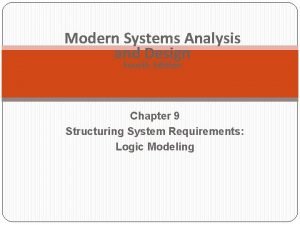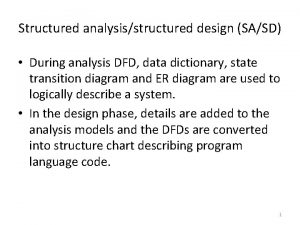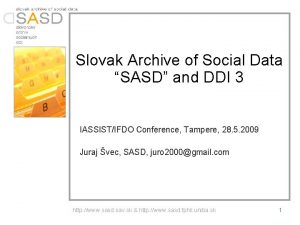Structured analysis and structured design SASD Jackson Structured








- Slides: 8

Structured analysis and structured design (SA/SD), Jackson Structured Development (JSD).

Introduction • Object oriented design is a method where developers think in terms of objects instead of procedures or functions. • SA/SD approach is based on the data flow Diagram. • JSD approach is action-oriented. • SA/SD is easy to understand but it focuses on well defined system boundary whereas JSD approach is too complex and does not have any graphical representation.

SA/SD • SA/SD is diagrammatic notation which is design to help people understand the system. • The basic goal of SA/SD is to improve quality and reduce the risk of System failure. • It establishes concrete management specification and documentation. It focuses on reliability, flexibility and maintainability of system. • In this system it involves 2 phases. – Analysis Phase: It uses DFD, Data Dictionary, State. Transition diagram and ER diagram. – 2) Design Phase: Structure Chart, Pseudo Code

SA/SD • Analysis Phase: – Data Flow Diagram: In a DFD model describe how the data flows through the system. – Data Dictionary: The content that is missing from DFD is described in the data dictionary. Data Dictionary defines the Data store and there relevant meaning. – State Transition Diagrams is similar to Dynamic model. It specifies how much time function will take to execute and data access triggered by events. – ER Diagram: It specifies the relationship between data store

SA/SD • Design Phase: Structure Chart, Pseudo Code – Structure Chart: It is created by the DFD. Structure Chart specifies how DFD‟s processes are grouped in to task and allocate to CPU‟s. – Pseudo Code: Actual implementation of the System.

Jackson Structured Development (JSD) • JSD was introduced by Michael Jackson in 1983. • The fundamental principle of JSD[6] is that it focuses on describing the real world by the system i. e. its main focus is to map the progress in the real world rather than specifying the functions performed by the system i. e its main focus is to map the progress in the real world. • JSD consist of three stages: – 1. Modeling Stage – This Stage comprises of Entity Action and Entity Structure. – 2. Network Stage – Initial model step, Function Step, and System Timing Step. – 3. Implementation Stage – Implementation Step.

JSD • In modeling stage the entity structure diagram has been created and identifies the entities and their actions. • In a network phase a set of sequential is expanded into a process network by addition of process for handling messages for external environment and generating system output. • In Entity Action the entities perform actions in time. The action is atomic and cannot be decomposed further. • Entity Structure Step partially sequences the order of action with respect to time.

JSD • In initial model step we concentrate on state vector and data stream communication. A data stream is an unbounded queue where read operator extracts the next record from the queue, if there are no records when the process executing the read operation waits until the record is available whereas in write operation data stream places the next record in the queue. In state vector we are present all the possible states of an entity. • Function step consist of pseudo code to the output of action generated from states. In this step the developer requires a complete specification of the system. • System Timing Step relates with the performance constraints of the system. • The implementation step focuses on process scheduling and allocates the number of processors required. The process may be different form the processors















